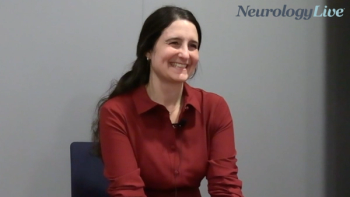
- New Directions and Practice Impacting Recommendations in Multiple Sclerosis
The Changing Paradigm of Multiple Sclerosis
The Lubin-Reingold classification for multiple sclerosis (MS), initially developed in 1996, categorized MS as following 1 of 3 distinct clinical courses: relapsing-remitting (RRMS; acute bouts of disease activity followed by clinical recovery), secondary progressive (SPMS; relapsing-remitting disease followed by ongoing progression later in the disease course), and primary progressive (PPMS; ongoing progression from the start).1
Although these classifications helped to standardize patient groups for MS trials and facilitated dialogue between patients and clinicians, these divisions of MS into relapsing and progressive categories is an artificial distinction without a biological basis. In response to this, Lublin and colleagues revised their classification system in 2013 to separately describe 2 separate pathophysiologic mechanisms contributing to MS. Inflammatory disease activity was reflected by clinical relapses, new T2 lesions, and/or gadolinium-enhancing magnetic resonance imaging (MRI) lesions. It coincides with breakdown of the blood-brain barrier and infiltration of peripheral immune cells into the central nervous system (CNS). In contrast, disease progression referred to slow accumulation of physical disability, usually in the absence of new MRI lesions. It likely represented a mismatch between chronic/ongoing injury (inflammation trapped behind a closed blood brain barrier, oxidative injury, axonal loss) and failure of regeneration/remyelination. This change in terminology allowed practitioners to more accurately identify individuals whose disease might respond to disease-modifying therapies (DMTs).1
The categories of relapsing and progressive MS persist, and this frequently generates confusion among patients and practitioners, as many fail to realize that MS exists on a continuum and that both inflammation (disease activity) and neurodegeneration (progression) co-exist within each patient regardless of whether that person carries a label of relapsing or progressive MS. The relative contribution of each of these pathologic processes varies depending on the individual patient. Younger patients usually exhibit a high degree of inflammation, while older patients are more likely to exhibit clinical manifestations of neurodegeneration. Nevertheless, new data have shown that even young MS patients with relapsing disease can still exhibit slow accumulation of neurologic disability.
Correspondingly, patients who are chronologically older may still exhibit signs of neuroinflammation.2-4 Patient-specific factors such as age (with accompanying decreases in neuroplasticity and immunosenescence), genetic background, comorbidities, and individual environmental exposures likely influence the balance between inflammation and neurodegeneration in MS.
Existing MS treatment strategies are highly impactful for ameliorating inflammatory disease activity. Few treatment strategies have been shown to similarly impact the neurodegenerative biology that underlies clinical disease progression. Additional MS treatments are needed to impact this aspect of MS pathogenesis.
MS as a Spectrum
The concept of relapsing MS can be misleading, because it fails to depict the presence of chronic inflammation and suggests a lack of disease progression. In fact, much of the disability progression in RRMS is not related to relapses.1 Progression independent of relapse activity (PIRA) describes slow accumulation of clinical disability that is not associated with a relapse. PIRA can be identified in patients at the earliest stages of MS, including those who are on highly effective DMTs.5 A strong association exists between older age and PIRA. Age-related cellular processes that promote inflammation and decrease neuroplasticity, in addition to the burden of comorbidities and reproductive aging, may contribute to this association.1
Looking even before the onset of clinical MS, accumulating evidence supports the existence of a preclinical disease state. Retrospective analysis of claims data found that individuals ultimately diagnosed with MS disproportionately accessed the health care system for more than 5 years before diagnosis, generally with nonspecific systemic complaints.6 Others were found to have MRI lesions strongly suggestive of MS yet had no neurologic symptoms that would suggest the disease. This phenomenon has been termed radiologically isolated syndrome (RIS). Over 50% of individuals with RIS go on to develop MS within a 10-year period, and careful evaluations can identify subtle yet nondiagnostic symptoms such as headaches, fatigue, or mild cognitive impairment in this patient population. Interestingly, RIS represents preclinical disease, but radiologic evidence suggests that some individuals with RIS may have had longstanding MS disease biology that may not be appropriately considered early MS. Some RIS patients, for example, exhibit numerous brain lesions along with thalamic atrophy; in these individuals, the underlying pathobiology has likely been longstanding in contrast to disease in some people with a first clinical demyelinating syndrome who have a low lesion burden and no significant atrophy.
Preclinical MS cannot yet be systematically identified, and management of patients with RIS is controversial since not all patients develop clinical disease. Ongoing research to help identify imaging markers or biomarkers associated with emerging disease may help to identify RIS patients who would benefit from treatment. At present, younger age at RIS diagnosis, presence of cerebrospinal fluid (CSF)-restricted oligoclonal bands, infratentorial/spinal cord lesions, and male sex are predictive of future disease. While RIS patients may have subtle neurocognitive deficits, many have limited resources that preclude testing. The decision about whether to treat a patient with RIS is nuanced, and it requires a high level of familiarity with the disease state. These patients will be best served by subspecialty trained neurologists (as opposed to receiving treatment from a general or community neurologist).
Measuring Disease Progression
The clinical phenomenon of disease progression, or slowly worsening disability in MS, is caused by a combination of multiple injurymechanisms (eg, nonresolving inflammation, neurodegeneration, oxidative stress, mitochondrial dysfunction) together with inadequate compensatory mechanisms (eg, remyelination/repair and neuroplasticity) that occur to varying degrees within an individual and are influenced by the aging process.1 Current methods of assessing disease progression in MS generally rely on demonstrating a persistently increased Expanded Disability Status Scale (EDSS) score, but this does not sufficiently or quantitatively capture several important functional domains (eg, upper extremity function, bladder impairment, fatigue, and cognition). In particular, fatigue and cognition are very poorly assessed by EDSS; therefore, the score may not reflect disease worsening, even if the patient’s subjective symptoms and experienced disability have changed dramatically. Improved methods for detecting disease progression are needed. An objective biologic-or biomarker-based approach would be particularly desirable for optimizing treatment and enhancing clinical trial design. Several promising biomarkers, including radiologic measures (such as paramagnetic rim lesions and slowly expanding lesions) and serologic biomarkers (such as serum neurofilament light chain or glial fibrillary acidic protein) are under investigation and are discussed further in the next article. Ideally, objective biomarkers evaluating each mechanism contributing to progression (eg, chronic inflammation, demyelination, oxidative injury) would be identified and used in parallel to better delineate where each patient was on the spectrum of MS.
Patient-reported outcomes and wearable devices offer increasingly sensitive ways to improve the clinician’s understanding of the patient’s daily life experiences and objectively identify disease progression. Systemic symptoms including cognitive impairment, fatigue, depression, and insomnia are common among patients with MS, and the degree to which these comorbidities are caused by the biologic mechanisms of MS-related injury, progression, and inflammation or by other comorbidities (eg, sleep disorders) and lifestyle factors (eg, sedentary behavior and lack of socialization) remains to be elucidated. These symptoms often have a strong effect on patients’ quality of life and psychiatric comorbidities.
Improving Quality of Life in MS
In addition to managing progression and disease activity in MS, clinicians should consciously evaluate and address symptoms that impact quality of life. MS management tends to focus heavily on DMT, and while this is incredibly important for long-term disease management, it has a relatively small impact on how patients experience MS on a day-to-day basis. Intentionally discussing modifiable factors including comorbidity management, exercise strategies, sleep hygiene, and diet can help improve quality of life and empower patients to take ownership in how they feel. Having a multidisciplinary team may facilitate addressing these lifestyle factors and managing the patient’s condition in a holistic way. Community-based activities in which people with MS gather together and engage in physical activity and brain health activities may also help build community and improve physical and mental health.
Environmental and geographic factors may also contribute to a patient’s ability to make beneficial lifestyle changes and a patient’s quality of life. For example, patients in colder climates may stay indoors if they are concerned about slipping on ice and thus become more deconditioned than are patients in warmer climates who are able to walk outside more frequently. On the other hand, patients who are highly heat sensitive may avoid going outdoors when the weather is warm and thus be susceptible to deconditioning. Understanding patients’ individual symptomatology and discussing personalized strategies to work around environmental barriers to exercise may be beneficial.
Conclusions
MS occupies a spectrum that includes overlapping pathologic and reparative processes that contribute to varying degrees; inflammation, neurodegeneration, and repair are simultaneously active for any given patient. Future research will need to focus on developing and standardizing biologically-based biomarkers of MS inflammation, progression, and repair and using them to develop personalized treatment approaches and algorithms.1
Faculty presenters: Stephen Krieger, MD; and Carrie M. Hersh, DO, MSc, FAAN. This article was reviewed, edited, and approved by Dr Krieger, Dr Hersh, and Dr Longbrake.
REFERENCES
1. Kuhlmann T, Moccia M, Coetzee T, et al. Multiple sclerosis progression: time for a new mechanism-driven framework. Lancet Neurol. 2023;22(1):78-88. doi:10.1016/S1474-4422(22)00289-7
2. Kawachi I, Lassmann H. Neurodegeneration in multiple sclerosis and neuromyelitis optica. J Neurol Neurosurg Psychiatry. 2017;88(2):137-145. doi:10.1136/jnnp-2016-313300
3. Hauser SL, Oksenberg JR. The neurobiology of multiple sclerosis: genes, inflammation, and neurodegeneration. Neuron. 2006;52(1):61-76. doi:10.1016/j.neuron.2006.09.011
4. Spain RI, Cameron MH, Bourdette D. Recent developments in multiple sclerosis therapeutics. BMC Med. 2009;7:74. doi:10.1186/1741-7015-7-74
5. Tur C, Carbonell-Mirabent P, Cobo-Calvo Á, et al. Association of early progression independent of relapse activity with long-term disability after a first demyelinating event in multiple sclerosis. JAMA Neurol. 2023;80(2):151-160. doi:10.1001/jamaneurol.2022.4655
6. Wijnands JMA, Kingwell E, Zhu F, et al. Health-care use before a first demyelinating event suggestive of a multiple sclerosis prodrome: a matched cohort study. Lancet Neurol. 2017;16(6):445-451. doi:10.1016/S1474-4422(17)30076-5
Articles in this issue
almost 2 years ago
Building Bridges to the Next Advances in Multiple Sclerosis Carealmost 2 years ago
The Role of Biomarkers in Multiple Sclerosisalmost 2 years ago
Treating Multiple Sclerosis Throughout the Life Cycle of DiseaseNewsletter
Keep your finger on the pulse of neurology—subscribe to NeurologyLive for expert interviews, new data, and breakthrough treatment updates.




















